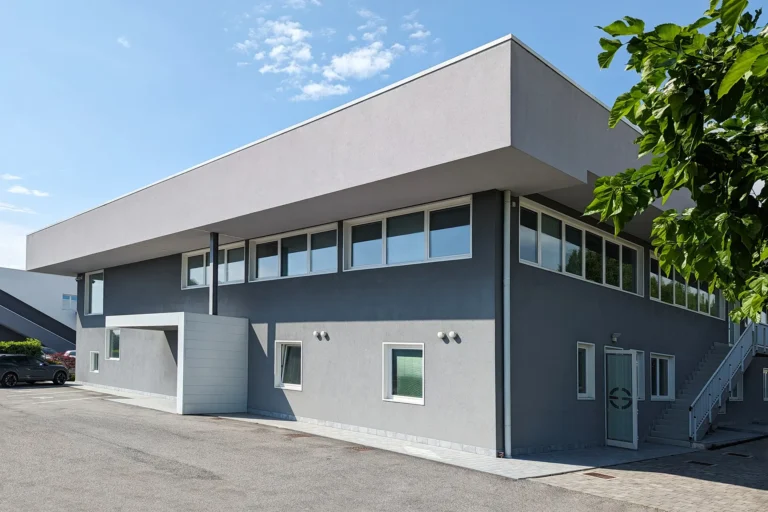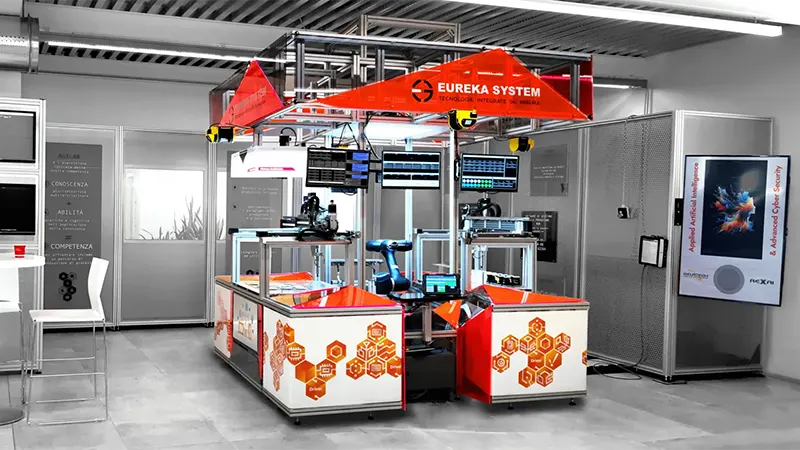Special Robotic Systems
Customised fixed and mobile robotic solutions
Robotic systems customised to automate specific production processes
The fixed and mobile robotic systems we propose are custom-designed and developed since we believe that manufacturing companies must be positioned to improve their production processes while preserving the peculiarities acquired in their business history.
- Robots for the Automation world, supporting industry and manufacturing: anthropomorphic arms, cartesian robots, SCARA robots, cobots, AMRs…
- Command and control of complex robotic tools
- Coordination of groups of fixed or mobile robots
- Optimised management of shared robot-robot and robot-human workspaces
- Various levels of interfacing with other company systems or external systems
SPECIAL ROBOTIC SYSTEMS
Industrial robots, suitable for both rigid and flexible Automation Systems
Advantages and benefits
- Increased productivity
- Positioning accuracy
- Improving plant flexibility
- Repeatability and versatility, thanks to the programmability of various operations
- Increased speed in repetitive handling and transport operations
- Quality Control: robotic applications for dimensional inspection, profile detection, detection of manufacturing defects, etc.
- Immediate adaptability to unforeseen situations thanks to special sensors
Anthropomorphic robots
For the past twenty years, Eureka System has been integrating Comau, Fanuc, Yaskawa, Staubli, and other industrial robots with 4 to 7 degrees of freedom, which have been studied and custom-developed for Handling, Welding, Assembly, and Machining applications.
The mechanical movement and configuration of anthropomorphic robots closely resemble those of a human arm. The arm is mounted on a base with a torsion joint, with a series of rotating joints acting as axes. Each additional joint or axis allows for more significant movement.
Typical applications for articulated robots are assembly, arc welding, material handling, machine tending, and packaging.
Autonomous Mobile Robots
Eureka System provides customised mobile robotics solutions, including AMRs with fleet management software. This software can be integrated with the company’s production management system, other business systems, and sensors.
Mobile robots (AMRs, or Autonomous Mobile Robots) are ideal for integrated logistics solutions and for automating transport and material handling operations.
Helko, our custom AMR, has a patented coupling system that can carry any industrial cart or assembly bench.
Find out more on the dedicated page → HELKO Autonomous Mobile Robot.
SCARA robots
SCARA robots are typically used to automate tasks requiring precise lateral movements, making them the ideal robotic solution for vertical assembly tasks.
SCARA robots are generally used for assembly and palletising, as well as in the biomedical and pharmaceutical industries. These industrial robots have four axes and four degrees of freedom. Commonly used in assembly applications, they are characterised by the cylindrical design of the arms, which move in the horizontal plane, and a gripper tool that can move up and down in the vertical plane.
SCARA stands for Selective Compliance Assembly Robot Arm or Selective Compliance Articulated Robot Arm. SCARA robots operate in three axes (X, Y, and Z) that allow rotary motion. They excel in lateral movements, are particularly fast, and integrate more easily than Cartesian robots.
Delta robots
Quick and efficient in carrying out rapid picking and positioning operations.
Delta or parallel robots have three arms connected to a single base mounted above the work area. The arms move a single tool within a dome-shaped work area and can move smoothly and precisely at high speed because all three arms directly control each joint of the final tool.
Delta robots are capable of delicate and precise movements. They are widely used for rapid picking and packaging in the food, pharmaceutical, and electronics industries.
CAM-Robot
With the CAM-Robot, Eureka System has developed a robotic solution capable of automatically interpreting CAD drawings into robotic paths for performing CNC machining for coating, cutting, welding, marking, dispensing, painting, and customising processes.
Our CAM-Robot is directly interfaced with G-CODE (DIN66025) interpreter software that automatically generates from CAD/CAM drawings the G-CODE code and high-precision robotic toolpaths for the robot with which it will machine and finish the workpieces. Since the machining operations can change with every work order, the robot can follow complex 3D fixed-angle trajectories previously unknown.
With our CAM-Robot, we have developed a robot capable of moving objects by performing traditional handling tasks and emulating a CNC machine by executing customised G-code paths.
Find out more → CAM-Robot
Cartesian robots
We design, engineer and develop single and multi-axis cartesian robots for handling, machining, and special applications.
Cartesian robots, also known as linear robots, are industrial robots that work on three linear axes, referring to a Cartesian coordinate system (X, Y, and Z). They move in a straight line along these three axes and may have a wrist that allows them to rotate.
Cartesian robots are a popular choice for many automation applications due to their high flexibility in configuration. They offer the possibility of defining and adjusting speed, precision, stroke length, and robot size. Cartesian robots are one of the most commonly used robot types in industrial applications and are often used in conjunction with CNC machines and 3D printing.
Collaborative Robots | Cobots
Collaborative robots, or cobots, are generally used for pick-and-place operations, palletising, quality controls, and machine tending. They can interact directly and safely with humans in a shared workspace.
Cobots are designed to work with people, not replace them. Precise, versatile, and efficient collaborative robots can help staff simplify their work or carry out dangerous, monotonous, or time-consuming tasks. This leaves operators in charge of all those activities with higher added value.
Particularly suitable for integration with other technologies, these industrial robots are incredibly versatile, with working spaces of up to 1.7 m and load capacities of up to 25 kg.
One of the most significant advantages of collaborative robots is that they can be easily reprogrammed to suit different applications without changing the production layout; this provides the flexibility needed to automate even small batches or frequent line changes.
An interesting feature is the so-called ‘point taking‘ functionality, i.e. the possibility to manually teach operations or dimensions to the cobot, which will memorise them and replicate them in automatic processes. It is possible to select different types of movement and save the coordinates with a simple ‘click’.
Depending on the cobot model and brand, several interconnection methods with production lines or other company systems are possible: serial communication, Ethernet, field bus, serial, Wi-Fi, TCP/IP, Modbus TCP (Master/Slave), Modbus RTU (Master), and PROFINET IO Device. A gateway can also be installed to expand the communication methods.
Find out more about our customisable application for labelling pallets with collaborative robots → IMPRONA -Print & Apply Labeling System
Gantry robots
Like cartesian robots, gantry robots are ideal for many industrial applications, including pick and place, sorting, labelling, measuring, control and inspection automation, and repetitive material handling.
A typical configuration of these robots includes two Y-axes and/or two Z-axes for increased load capacity and rigidity. Still, the distinguishing feature of a gantry robot is its two basic axes (X). These robots’ accuracy, speed, length, and stroke size can be adjusted, and various types of linear actuators can be installed. Since the robot structure supports the Y-axis well, gantries can handle considerable loads and have much longer stroke lengths than ordinary Cartesian robots.
Special robotic systems
Custom-developed, fully integrated robotics solutions
Our solutions are consistently tailored to meet businesses’ unique needs. We don’t believe in a ‘one-size-fits-all’ approach, as we understand that each company has distinctive production intricacies that define its individuality.
If you're looking to bring innovation to your company while preserving your established production methods, we're here to assist you
Thanks to our vast experience in the automation field, we apply skills developed in different industries to carefully study the customised solution that best suits your business needs. When you decide to integrate a robot into your production processes, you have to carefully consider a series of crucial factors: load, orientation, speed, reach, precision, environment, work cycle, required flexibility, ROI, etc. Analysing these factors leads to a technical-economic feasibility study, which considers the robotic system as a whole and makes it possible to evaluate the type of robot that can guarantee the company’s most efficient and effective results.






